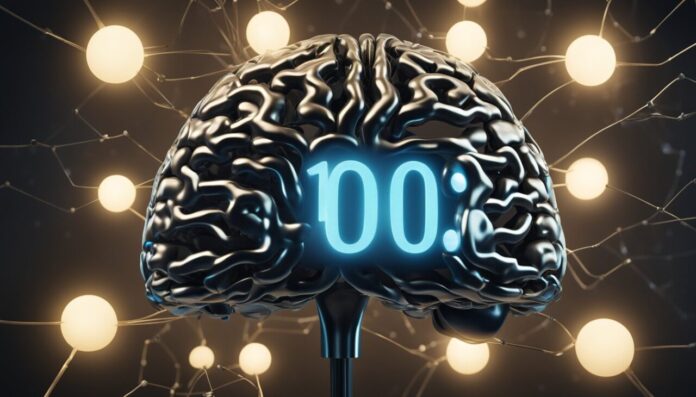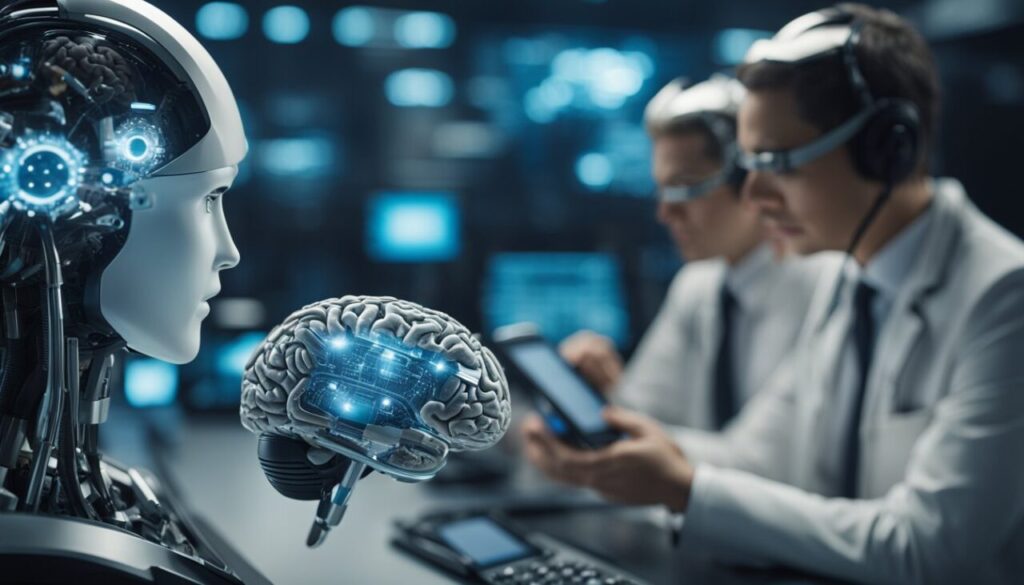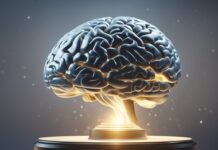
What if humans could use 100% of their brains? This question has been a topic of discussion and debate for decades.
Many people believe that humans only use a small percentage of their brain capacity and that if we were able to access the full potential of our brains, we could achieve incredible feats of intelligence, creativity, and even psychic abilities.
However, the idea that humans only use 10% of their brains is a myth.
Nonetheless, according to a survey from 2013, around 65% of Americans believe this myth.
In reality, humans use much more than 10% of their brains, and different parts of the brain are active depending on the task at hand.
Animal studies have found that more than 90% of the brain is active at any given time, even during sleep.
Despite the common misconception, the question of what would happen if humans could use 100% of their brains is still an intriguing one.
So, let’s explore the human brain in more detail.
Related:
The Human Brain Capacity

Current Understanding of Brain Usage
The human brain is a complex and fascinating organ that has been studied for centuries. Despite all the research, there is still much we don’t know about how the brain works.
According to a Smithsonian Magazine article, humans use all parts of their brains, but not all at the same time. Different parts of the brain are responsible for different functions, such as movement, language, and memory. The brain is a complex organ that is constantly active, even when a person is sleeping.
The human brain has an incredible potential that is largely untapped.
While it is not true that humans only use 10% of their brain capacity, it is true that we do not use our brains to their full potential.
The brain has the ability to learn, adapt, and change throughout our lives. With practice, we can improve our memory, focus, and cognitive abilities
And so, it can be said with certainty that some individuals utilize a higher percentage of their brains compared to others.
Having said that we must ask ourselves – where did that myth come from?
Interesting fact: One fascinating yet lesser-known fact about the human brain is that it generates about 20 watts of electrical power when awake. Despite weighing only about 3 pounds, the brain is a highly efficient organ, and this energy output is enough to power a dim light bulb. It's incredible to think that the very organ responsible for our thoughts, emotions, and actions operates with such energy efficiency.
Neurological Myths and Misconceptions

The myth that humans only use 10% of their brains is not rooted in scientific evidence and is widely considered a misconception.
The origins of this myth are somewhat unclear, but it has been perpetuated over the years through popular culture and misinterpretations.
One possible source is misattributed to William James, an influential American psychologist and philosopher from the late 19th and early 20th centuries.
Although James did discuss the idea of using only a small part of our mental potential, he never specified a particular percentage.
The myth gained further momentum in the early 20th century, possibly fueled by self-help and motivational literature.
It may have been popularized by figures like psychologist William McDougall or even by Dale Carnegie, who wrote about untapped human potential.
The 100% brain usage myth has been further popularized in movies, television shows, and books.
For example, the 2014 movie “Lucy” starring Scarlett Johansson is based on the premise that humans can unlock the full potential of their brains and then become almost godlike creatures.
The idea that humans only use a small portion of their brains has also been used in marketing campaigns for brain supplements and other products.
Evolution Does not Allow any Wastefulness

The human brain is an incredibly complex and energy-intensive organ. It is estimated that the brain uses around 20% of the body’s energy despite only representing about 2% of its weight.
And so, evolution is rather important in deconstructing this myth.
Namely, evolution (in most cases) does not allow for any wastefulness, and it is unlikely that the brain would have evolved to only use a small percentage of its capacity.
As mentioned, studies have shown that humans use all parts of their brains, even when performing simple tasks.
But can we somehow increase the function of our brains?
Let’s explore the scientific perspective.
Scientific Perspective

Brain Functionality and Plasticity
The brain is a highly complex and adaptable organ that is capable of changing and adapting throughout a person’s life. This process is known as neuroplasticity, and it allows the brain to form new connections and reorganize existing ones in response to experiences and environmental factors.
Psychedelics and Neuroplasticity
Recent studies have suggested that certain psychedelic substances, such as psilocybin and LSD, may have the potential to enhance neuroplasticity and promote the growth of new neural connections.
While more research is needed in this area, these findings suggest that psychedelics may have therapeutic potential for conditions such as depression, anxiety, and addiction.
But these are not the only categories of potential brain function enhancements.
Namely, with advanced technologies coming in the future (and some already available now), we can expect further brain development.
Technological Considerations

Neurotechnology Advances
Recent advances in neurotechnology have allowed for the development of brain-computer interfaces (BCIs) that can read and interpret brain activity. These BCIs have the potential to greatly enhance human abilities.
As technology advances, it may be possible for individuals or organizations to use BCIs to read people’s thoughts or manipulate their behavior.
The idea of using advanced technology to increase brain performance raises big ethical concerns about the use of these brain augmentation technologies.
Namely, If everyone had access to brain augmentation technologies at the same time that would be okay.
However, as we know, the riches of this world will have this technology first, creating an even bigger divide in society.
Additionally, there are concerns about the potential for brain augmentation to be used for military or surveillance purposes.
We’ll see what the future brings, but one thing is certain: in the next 10 or 100 years, there will be widely available gadgets that can enhance brain functions to unimaginable levels.
And so, let’s explore this concept in more detail, especially keeping in mind recent developments in AI.
Brain Enhancements in the Future with AI and Smart Gadgets Implanted in Brain

As technology advances, the possibility of enhancing brain function using AI and smart gadgets implanted in the brain becomes more feasible.
The concept of brain implants has been around for years, but recent advancements in technology have made it more realistic than ever before.
One potential application of brain implants is to help individuals with cognitive disabilities, such as Alzheimer’s disease or traumatic brain injuries. The implant could help restore lost cognitive functions and improve quality of life.
Another potential application of brain implants is to enhance cognitive abilities in healthy individuals. For example, a brain implant could help improve memory, attention, or decision-making skills.
In addition to brain implants, smart gadgets such as virtual assistants and wearable devices could also be implanted in the brain to enhance cognitive functions.
We’ve explored similar concepts in our articles ‘What the World Will Look Like in 2050‘ and ‘What The Future Will Look Like.’
Certainly, the further we progress into the future, the more brain implants we will witness.
This could potentially lead to some individuals becoming ‘superhumans‘ before others, thereby creating unimaginable advantages for those people.
Conclusion

In conclusion, while the idea that we only use 10% of our brains is a myth, some individuals certainly possess significantly ‘stronger’ brains than others. Indeed, the brain can be likened to a muscle; the more you work it, the stronger or smarter it becomes.
Nevertheless, all people are different, and everyone has unique brains.
How our brains will evolve in the future remains a question.
However, it is evident that, just as we currently have gadgets and implants aiding physical activities like moving, running, or climbing, soon we may have implants that enhance memory and potentially allow humans to access the entirety of worldly knowledge through a small device implanted in the brain.
As a society, we must ensure that this technology is not misused for negative purposes.
Hopefully, it will not be!
Frequently Asked Questions

What are the methods to unlock full brain potential?
There is no scientifically proven method to unlock ‘full’ brain potential. The idea that humans only use a small percentage of their brain is a myth. The brain is a complex organ that is constantly active, even during sleep. However, there are ways to improve brain function, such as engaging in regular physical exercise, getting enough sleep, eating a healthy diet, and practicing cognitive training exercises.
Is there a limit to human brain capacity?
The human brain has a remarkable capacity for learning and adapting. However, there is a limit to the amount of information that can be stored in the brain. The exact limit is not known, but studies suggest that the brain can hold up to 2.5 petabytes of information, which is equivalent to 2.5 million gigabytes.
How much of their brain do geniuses typically utilize?
There is no evidence to suggest that geniuses utilize a higher percentage of their brain than the average person. In fact, studies have shown that the brains of geniuses are not structurally different from the brains of non-geniuses.
What are the scientific findings on brain usage from reputable institutions like Harvard?
Harvard University has conducted extensive research on brain function and cognition. Some of their findings include the fact that the brain is constantly changing and adapting, and that cognitive training exercises can improve brain function. They have also found that the brain’s ability to process information declines with age, but that this decline can be slowed down through regular exercise and mental stimulation.
In what ways can our brain’s power be measured or quantified?
The power of the brain cannot be directly measured or quantified. However, there are ways to indirectly measure brain function, such as through cognitive tests, brain imaging techniques like MRI and fMRI, and EEG recordings.
What misconceptions exist regarding the percentage of the brain used by humans?
One of the most common misconceptions is that humans only use 10% of their brain. This is a myth that has been debunked by scientific research. Another misconception is that being left-brained or right-brained affects personality and cognitive abilities. While there are differences in brain function between the two hemispheres, there is no evidence to suggest that people are either left-brained or right-brained.




















